
The Canadian Army is the command responsible for the operational readiness of the conventional ground forces of the Canadian Armed Forces. As of 2022 the Canadian Army has 23,000 regular soldiers, 19,000 reserve soldiers, for a total of 42,000 soldiers. The Army is also supported by 3,000 civilian employees from the civil service. It maintains regular forces units at bases across Canada, and is also responsible for the Army Reserve, the largest component of the Primary Reserve. The commander of the Canadian Army and chief of the Army Staff is General Wayne Eyre.
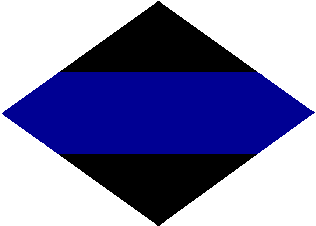
The 2nd Canadian Armoured Brigade was an armoured brigade of the Canadian Army that saw active service during World War II. The brigade was composed of the 6th, 10th and 27th Canadian Armoured regiments and saw service in northwest Europe, landing in Normandy on D-Day and remaining in combat up to Victory in Europe Day.

The 3rd Canadian Division is a formation of the Canadian Army responsible for the command and mobilization of all army units in the provinces of Manitoba, Saskatchewan, Alberta and British Columbia, as well as all units extending westwards from the city of Thunder Bay.
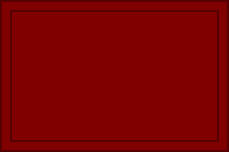
The 5th Canadian Division is a formation of the Canadian Army responsible for the command and mobilization of most army units in the provinces of New Brunswick, Nova Scotia, Prince Edward Island and Newfoundland and Labrador; as well as some units in Kingston, Ontario. The division is recognized by the distinctive maroon patch worn on the sleeve of its soldiers.

The South Alberta Light Horse (SALH) is a Canadian Army armoured reconnaissance regiment of the Canadian Army Reserve. It traces its complicated lineage to the Rocky Mountain Rangers, and claims its direct ancestry to the 15th Light Horse, along with various other Alberta based cavalry units. The "Light Horse" designation comes from its light cavalry and mounted infantry origins.

The 12e Régiment blindé du Canada is a Canadian Army armoured regiment based in CFB Valcartier, on the outskirts of Quebec City. The regiment has both a Regular Force and a Primary Reserve unit. The 12e Régiment blindé du Canada's abbreviation is 12e RBC.
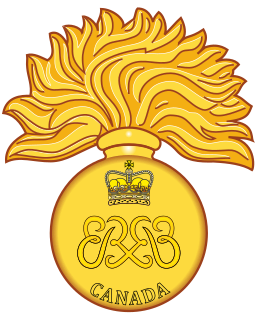
The Canadian Grenadier Guards (CGG) is a reserve infantry regiment in the 34 Canadian Brigade Group, 2nd Canadian Division, of the Canadian Army. The regiment is the oldest and second-most-senior infantry regiment in the Primary Reserve of the Canadian Army. Located in Montreal, its primary role is the provision of combat-ready light infantry troops in support of Canadian regular infantry. It is a Household Foot Guard regiment and also provides soldiers for public ceremonial duties, performing similar ceremonial duties to the Guards regiments of the British Army. This primarily entails mounting the guard on Government House, the Governor General's residence, and performing the "Changing the Guard" ceremony on Parliament Hill in Ottawa, a task it shares with Canada's senior Household Foot Guard regiment, the Governor General's Foot Guards of Ottawa. The Canadian Grenadier Guards is an allied regiment to the British Grenadier Guards.

The Queen's Royal Irish Hussars, abbreviated as QRIH, was a cavalry regiment of the British Army formed from the amalgamation of the 4th Queen's Own Hussars and the 8th King's Royal Irish Hussars in 1958. The regiment saw active service against insurgents in Aden; during the Indonesia–Malaysia confrontation and during the Gulf War, as well as regular service in West Germany as part of the British Army of the Rhine. The regiment was amalgamated with the Queen's Own Hussars to form the Queen's Royal Hussars on 1 September 1993.

The King's Own Calgary Regiment (RCAC),, is a Canadian Army armoured reconnaissance regiment of the Canadian Armed Forces Primary Reserve. Headquartered at the Mewata Armoury in Calgary, Alberta, the KOCR is a part-time reserve unit of 3rd Canadian Division's 41 Canadian Brigade Group. Its regimental museum is located in Calgary.

The 4th Princess Louise Dragoon Guards is an inactive armoured regiment of the Canadian Militia / Canadian Army. It is currently on the Supplementary Order of Battle.

The 1st Hussars is an armoured Primary Reserve regiment of the Canadian Armed Forces, based in London and Sarnia, Ontario.

The Royal Canadian Armoured Corps is the armoured corps within the Canadian Army, including 3 Regular and 18 Reserve Force regiments as well as the Royal Canadian Armoured Corps School.

The 8th Canadian Hussars is an armoured regiment in the Canadian Army. It was formed on the 4 April 1848 in New Brunswick where it has served continually ever since. Today it is a reserve armoured reconnaissance regiment with two squadrons. Its Regimental Headquarters (RHQ) and A Squadron are located in Moncton with B Squadron located in Sussex, New Brunswick.

The Sherbrooke Hussars is a Primary Reserve armoured regiment of the Canadian Forces and perpetuates the Sherbrooke Fusilier Regiment of the Second World War.
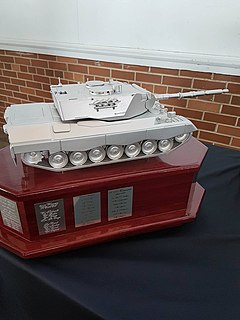
The Worthington Trophy is a Canadian military award. It was awarded annually to the best reserve armoured unit in the Canadian Land Forces. It is named after Major-General F. F. Worthington, known as Fighting Frank – "The Father of the Royal Canadian Armoured Corps".
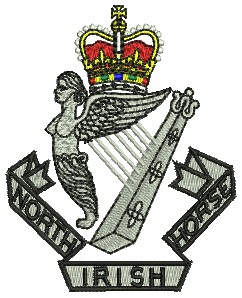
The North Irish Horse is a yeomanry unit of the British Territorial Army raised in the northern counties of Ireland in the aftermath of the Second Boer War. Raised and patronised by the nobility from its inception to the present day, it was one of the first non-regular units to be deployed to France and the Low Countries with the British Expeditionary Force in 1914 during World War I and fought with distinction both as mounted troops and later as a cyclist regiment, achieving eighteen battle honours. The regiment was reduced to a single man in the inter war years and re-raised for World War II, when it achieved its greatest distinctions in the North African and Italian campaigns. Reduced again after the Cold War, the regiment's name still exists in B Squadron, the Scottish and North Irish Yeomanry and 40 Signal Squadron, part of 32 Signal Regiment.
Beginning with establishment of Fort Calgary in 1875, the city of Calgary, Alberta, has had some degree of permanent military presence throughout its history.
All units of the Canadian Armed Forces have an order of precedence that determines seniority; it often decides such matters as which unit forms up to the right of other units on a ceremonial parade, or the order in which marches or calls are played at a mess dinner.

Armoured reconnaissance is the combination of terrestrial reconnaissance with armoured warfare by soldiers using tanks and wheeled or tracked armoured reconnaissance vehicles. While the mission of reconnaissance is to gather intelligence about the enemy with the use of reconnaissance vehicles, armoured reconnaissance adds the ability to fight for information, and to have an effect on and to shape the enemy through the performance of traditional armoured tasks.

The structure of the British Army of the United Kingdom (UK) will be reorganised in 2022 with the Future Soldier reform. The British Army is commanded by the Chief of the General Staff (CGS), with Army Headquarters which is located in Andover, Hampshire. Subordinate to that post, there is a Commander Field Army, and a personnel and UK operations command, Home Command.


















